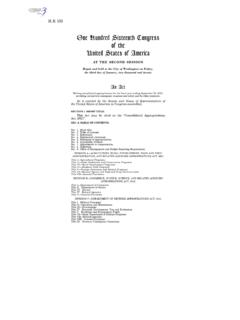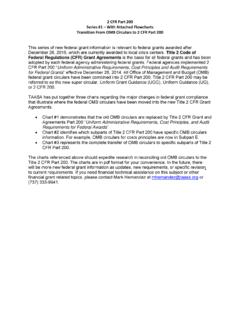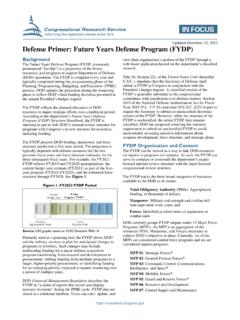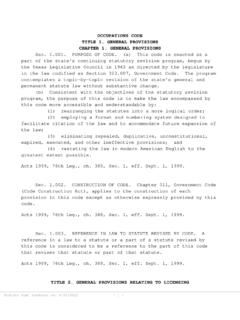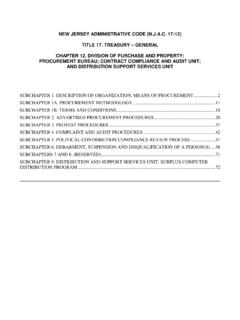Transcription of 2019 Title 24 Lighting Guide California Building Energy ...
1 California Building Energy Efficiency StandardsTitle 24 Lighting Guide2019 PUBLISHED 2020 Cooper Lighting Solutions Title 24 Guidelines (2019 Standards)Cooper Lighting Solutions Title 24 Guidelines (2019 Standards)23 Title 24 Guidelines for Controlled LightingThis Guide is designed to serve as a resource for industry professionals involved in the design, construction or retrofit of California s buildings. The Guide includes compliance requirements and recommendations forimplementing Title 20 Appliance Efficiency Regulations and the 2019 Title 24 Building Standards Energy Code in New Construction, Addition or Alteration projects and provides links to Cooper Lighting Solutions products and services available to facilitate California s ambitious goals of Energy conservation that are applied across North America. While Energy efficiency is a priority in today s Lighting design practice, so are occupant comfort, health and wellness.
2 A successful Lighting design balances these objectives where Cooper Lighting Solutions can assist to achieve those to consider in Lighting design include human needs, like visibility, safety and comfort; and environmental and economic issues, such as Energy , equipment costs and sustainability. Additionally, how well the Lighting complementsthe Building design must be considered. A successful Lighting design utilizes the right equipment to maximize visualcomfort while reducing Energy consumed, installation/operating costs and the Building s carbon footprint. Adding task and accent Lighting to ambient Lighting , also referred to as general Lighting , allows the ambient lightingloads to be reduced without compromising safety or visual comfort. This layered approach to Lighting improves visualcomfort by reducing contrast and glare. Lighting controls address an entire space or area. These controls are typically programmed to provide generalpurpose areas with Energy -efficient control strategies.
3 Personal Lighting controls address a sub-area and are typicallyassociated with work stations or task areas. An effective Lighting system combines the right light source, suitable luminaire and the appropriate controls for desired function and effect. A higher up-front investment in a more efficient, functional Lighting system yields a better long term compared to lower cost alternatives, especially in retail, hospitality and healthcare applications where Lighting quality influences critical success S NEW IN 2020On January 1, 2020, new 2019 California Title 24 (T24), Part 6 Building Energy Efficiency Standards went intoeffect with significant updates. These standards are updated every three years. Cooper Lighting Solutions offers themost comprehensive coverage of products and services to help you comply. We are industry s leaders for Title 24. NON-RESIDENTIAL APPLICATIONSLIGHTING POWER ALLOWANCES On average, indoor Lighting power allowances have been reduced by 37% for the Complete Building Method and 29% for the Area Category and Tailored Method.
4 Outdoor Lighting power allowances have been reduced by an average of 23%. These reductions are based on the assumption that all New Construction, Alterations and Additions will be installing LED Lighting technologies by January 1, 2020. The California Energy Commission estimates this to be the single largest savings in the 2019 Energy Code for nonresidential ADJUSTMENT FACTORS New power adjustment factors (PAFs) have been added to encourage the use of clerestory fenestration, horizontal slats and light shelves. Existing PAFs from the 2016 Energy Code also remain as options, for a total of seven , ALTERATIONS AND REPAIRS: The Additions, Alterations and Repairs section has been , the trigger for all Alterations is 10% of the luminaires serving an enclosed space. Similar to 2016, there arethree paths to compliance, but now, all share a universal set of exemptions and more clear-cut APPLICATIONS(INCLUDING HIGH/LOW RISE MULTI FAMILY BUILDINGS)NEW LIGHT SOURCE CATEGORIES ADDED Step lights and path lights are now included in the same category as night lights.
5 Light sources integral to drawers, cabinets and linen closets are now regulated by the Energy Code. If these light sources are greater than 5 watts or emit more than 150 lumens, they must comply with the high-efficacy requirements of Table and be controlled by a vacancy sensor; otherwise, the light sources are exempt. Additionally, light sources in drawers, cabinets and linen closets must be equipped with controls that automatically turn the light off when the drawer, cabinet or linen closet is UPDATE Light sources meeting the new 2019 JA8 ( Title 24) performance requirements must mark the light source itself with JA8-2019, or JA8-2019-E for products that also have passed the ENERG STAR Product Specification Version Elevated Temperature Life Test and/or Rated Life Test. Products certified to JA8-2016 do not need to be retested or recertified to remain compliant with JA8-2019/JA8-2019-E.
6 These products may be marked with JA8-2019/JA8-2019-E. Additionally, products marked with JA8-2016/JA8-2016-E may be installed in permitted QUALITY JA8 now aligns with the Appliance Efficiency Regulations for color rendering index (CRI) requirements of state-regulated LED lamps. In addition, the 2019 JA8 now requires that all light sources be capable of providing a correlated color temperature (CCT) of 4,000 Kelvin or RESIDENTIAL BUILDINGS In low-rise multifamily residential buildings where the total interior common area is more than 20% of the floor area, the permanently installed Lighting for the interior common areas must adhere to the nonresidential requirements. In high-rise residential buildings, all common areas must meet the nonresidential Lighting and controlled receptacle requirements. Lighting in the dwelling units must meet the residential Lighting requirementsCALIFORNIA Energy COMMISSION ESTIMATED REDUCTION BENEFITS FROM CODE COMPLIANCE:Annual Energy savings 2019 Code offers 53% Savings overthe 2016 Residential Guidelines.
7 85,000 GW/h electricity savingstarget by 2030, compared to air quality and emission reductions per year 700 Metric Tons of Greenhouse Gas reductions in next three years. 115,000 Fossil fueled cars removed from California roads in next three Guide was developed based upon published Building Energy Efficiency Standards for Residential and Nonresidential Buildings (CEC-400-2018-020-CMF), Residential Compliance Manual for the 2019 Building Energy Efficiency Standards (CEC-400-2018-017-CMF), and Nonresidential Compliance Manual for Building Energy Efficiency Standards (CEC-400-2018-018-CMF) (collectively, the code ); it is not intended to replace the code nor be a source of expertise that interpret the code. This training material is based on CEC T24 code as it exists at the time of publication, and may be updated without notice. Cooper Lighting Solutions accepts no liability for the content of this publication, or the consequences of any action taken on the basis of the information provided herein.
8 California Energy Commission Building Energy Efficiency Standards documents can be found at: Title 24 - Lighting GuideWhat s Covered HereCooper Lighting Solutions Title 24 Guidelines (2019 Standards)Cooper Lighting Solutions Title 24 Guidelines (2019 Standards)45 WHEN IS Title 24 COMPLIANCE REQUIRED?Overview for Non-Residential ComplianceOverview for Residential ComplianceStep 1 Selection ProcessStep 2 CONSTRUCTION / PROJECT TYPEREQUIREDNew ConstructionYESM eeting Title 24 is required for all residential and nonresidential new construction Title 24 is required for all residential and nonresidential (classified as Retrofit thatchange the space occupancy classification)ConditionalBased upon the resulting Lighting power density and if greater than 10% ofluminaires altered. Refer to Table ; Sections (b)2F - (b)2 KModification-in-Place (classified as Retrofit when luminaires are modified with kits))ConditionalBased upon the resulting Lighting power density and if greater than 10% ofluminaires altered.
9 Refer to Table ; Sections (b)2F - (b)2 KRepairsConditionalBased upon the resulting Lighting power density and if greater than 10% ofluminaires altered. Refer to Table ; Sections (b)2F - (b)2 KTITLE 24: Basic InformationTITLE 24: Basic Information1. MANUAL AREA CONTROL for each area enclosed by ceiling height MULTILEVEL Lighting CONTROL for any area>100 with a connected Lighting load > SHUT-OFF CONTROLS automatically reduce Lighting load in unoccupied spaces and to preset normal occupancy AUTOMATIC DAYLIGHTING CONTROLS adjust Lighting power, keeping light level stable as incoming daylight AUTOMATED DEMAND RESPONSE implements functions requested by a compliant PERFORMANCE APPROACH: Software-based method that uses Energy modeling to plan for an Energy -efficient total Building . Not suitable for Lighting only projects. 2. PRESCRIPTIVE APPROACH: Complete Building Method; Area Category Method; Tailored Method; all use allowed Lighting Power Density (LPD) plus special allowances.
10 T24/2019 reduced complete Building power allowance by 37% indoors and 23% outdoors, assuming LED TAILORED METHOD: Uses target illuminance values and calculated based upon the room cavity ratio to determine LPD for general Lighting and allows for additional allowances for ornamental, wall display, etc. INTERACTIONS liaise all control functions within THE FOLLOWING MANDATORY MEASURES FOR EACH SPACESTAY WITHIN ALLOWABLE Energy BUDGETUSING EITHER OF THESE OPTIONS:Egress Requirements for Meeting Title 24 (Nonresidential only) Title 24 makes special accommodations for egress Lighting and must be identified on the Building design documents. Egress must be shut off after typically unoccupied times, except in offices ( W/ft2 allowed 24/7).SPACE TYPEREQUIREDExitYesExit signs shall meet Appliance Efficiency Regulations and be certified to California Title 20 Appliance LevelNoUp to Watts per sq.
